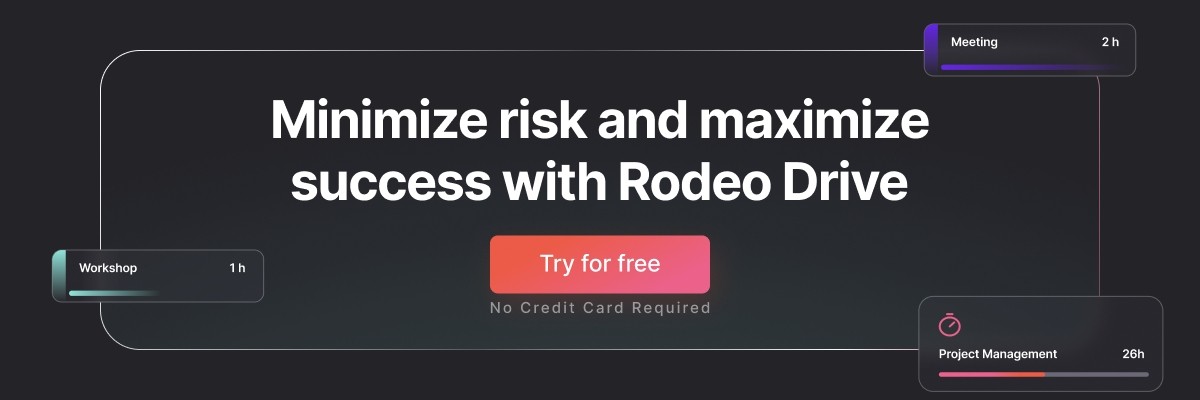How to Effectively Balance the Project Management Triangle
Navigating the project management triangle — scope, cost, and time — is essential for any project's success. As a project manager, keeping these constraints in balance ensures that projects are delivered efficiently and result in a high-quality product.
Maintaining a well-balanced triangle has tangible benefits, from enhanced stakeholder satisfaction to increased project project agility. This article will explore some of those benefits and provide actionable tips for balancing scope, cost, and time.
Whether you're a seasoned project manager or new to the field, understanding how to effectively navigate the project management triangle is key to steering your projects toward their objectives.
What’s the project management triangle?
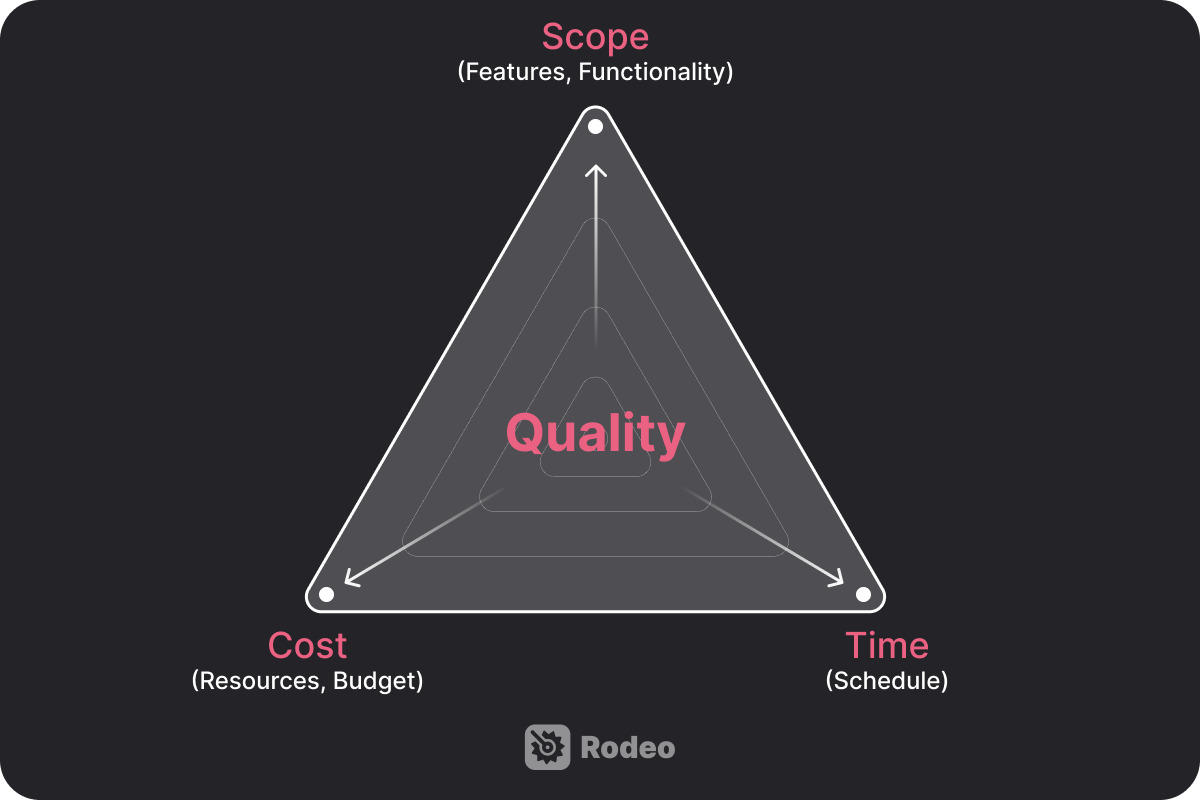
The project management triangle, also known as the iron triangle, represents the triple constraint that project managers must navigate through for success. It highlights the interconnected relationship between scope, cost, and time in project management.
The triangle conveys the principle that changes in any of these three project constraints bring tradeoffs in the others. For example, a project manager trying to implement a technique like resource leveling, which extends the project timeline, might need to accept a tradeoff in terms of higher costs. Or, to deal with time constraints from unchangeable deadlines, a project manager might need to draw clear limitations in the project scope.
The 3 key constraints
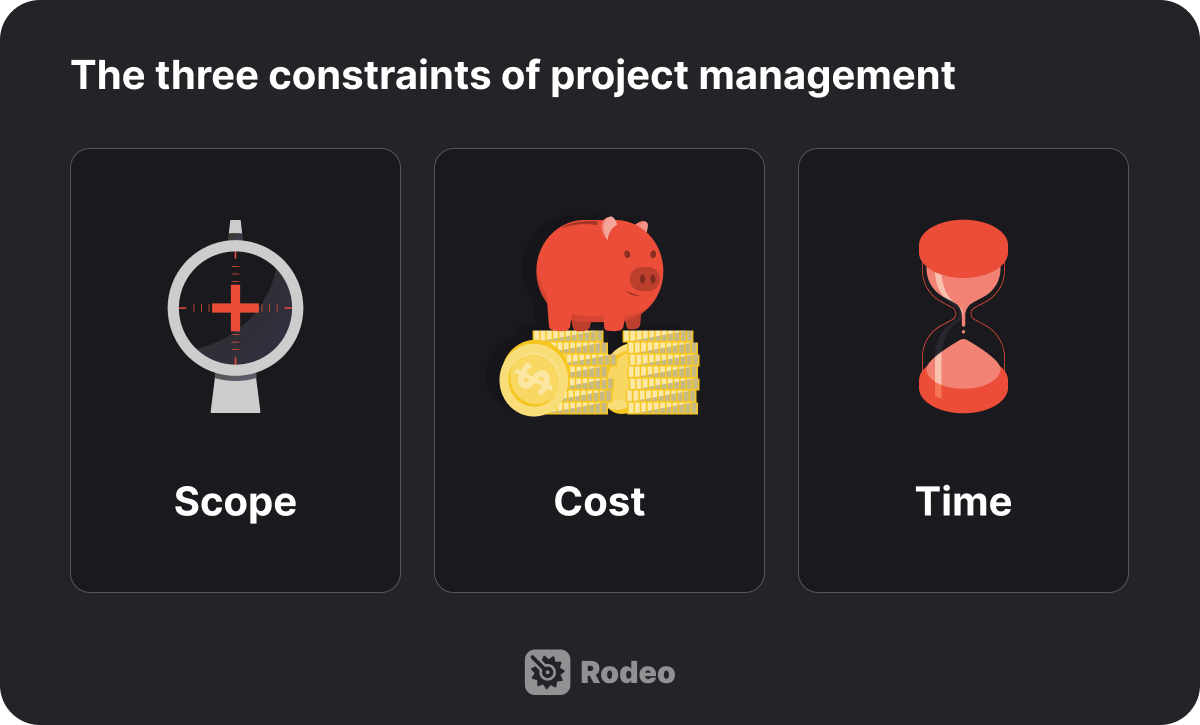
Every project manager knows that countless constraints beyond the three mentioned can impact a project. However, the constraints in the project management triangle are the most broadly applicable, being present in practically every form of project.
Project management, as a discipline, therefore gives particular importance to handling these constraints.
Scope
The project scope outlines the goals, deliverables, tasks, and boundaries of the entire project. Scope is a common constraint because time is finite and projects operate within resource constraints, which limit what a project can achieve.
A well-articulated project scope prevents scope creep, a common risk wherein a project’s scope expands beyond its original boundaries after the project is already underway. This can derail projects by introducing additional tasks and requirements that the project team doesn’t have the time or resources to achieve.
Project managers control scope to provide a focused path toward the project’s most important objectives. That includes setting clear expectations and success criteria for team members at the outset.
Cost
Projects either seek profit or aim to deliver long-term value to an organization.
That, and the fact that projects are budget-constrained, means that cost management is a key project constraint. Maintaining the financial health of projects requires an accurate balance of estimating costs, allocating resources appropriately, and controlling project expenses to stay within the approved budget.
Project managers can monitor this constraint with the help of project management software, which offers tools for budget tracking, time tracking, invoicing, and expense reporting.
These tools can be paired with cost management strategies like regular financial reviews and cost optimization to minimize the pitfalls associated with budget overruns.
Time
Time constraints are about submitting deliverables within the set deadlines of a project. A large part of a project manager's job is defining the project schedule — planning activities and assigning specific tasks to make sure key components of the project are completed within time constraints.
In cases where deadlines are inflexible and deliverables are at risk of not being completed, a project manager might apply a technique like resource smoothing, which reallocates additional resources to the project so that deadlines are met. This comes at the expense of extra costs and removing resources from other projects.
Understanding the relationship between scope, cost, and time in the triangle
We’ve touched on the principle that a change in one constraint impacts the other two. For instance, expanding the project scope typically demands more time and increases costs. Or, reducing costs may necessitate scaling down the scope or extending timelines to accommodate budget constraints.
Let’s further explore each of these constraints as they relate to each other.
Relationship between scope and cost
The relationship between scope and cost is perhaps the most intuitive. As the scope of a project expands, incorporating more features, tasks, or quality requirements, the associated costs naturally increase. For project managers, this relationship underscores the necessity of rigorous scope definition and change management processes to control the project budget effectively.
Conversely, trimming the project scope in an effort to cut costs should be carefully managed to avoid undermining the project’s objectives or the quality of deliverables.
Also read: How to Conduct a Cost-Benefit Analysis for Successful Projects
Relationship between time and scope
The time-scope interaction is similarly important. Assuming resources stay the same, a broader scope requires more time to execute. And if project timelines are compressed without decreasing the scope or increasing resources, the quality of deliverables tends to suffer. Therefore, project managers need to plan a realistic schedule to accommodate the full project scope within the available timeframe.
Relationship between cost and time
The cost-time interaction is also characterized by trade-offs. Generally, extending a project timeline leads to higher total costs due to prolonged resource utilization and operational expenses.
However, in some cases, extending the timeline allows for more efficient resource allocation, the opportunity to defer the use of budget, or the ability to secure better rates or terms from suppliers, potentially offsetting those cost increases.
Alternatively, accelerating a project to reduce its duration will demand additional resources or overtime work, increasing immediate costs, but can lead to potential savings in the long run since the project duration is shortened.
Overall, the project management triangle emphasizes the ripple effect each of these constraints has on the others. As a project manager, making informed, strategic decisions that balance the variables in the triangle creates the best outcomes for your projects within the constraints of the real world.
Accomplishing this requires a clear understanding of priorities, the ability to respond to changes, and the skills to communicate and negotiate with other stakeholders.
Why is it important to keep the project management triangle balanced?
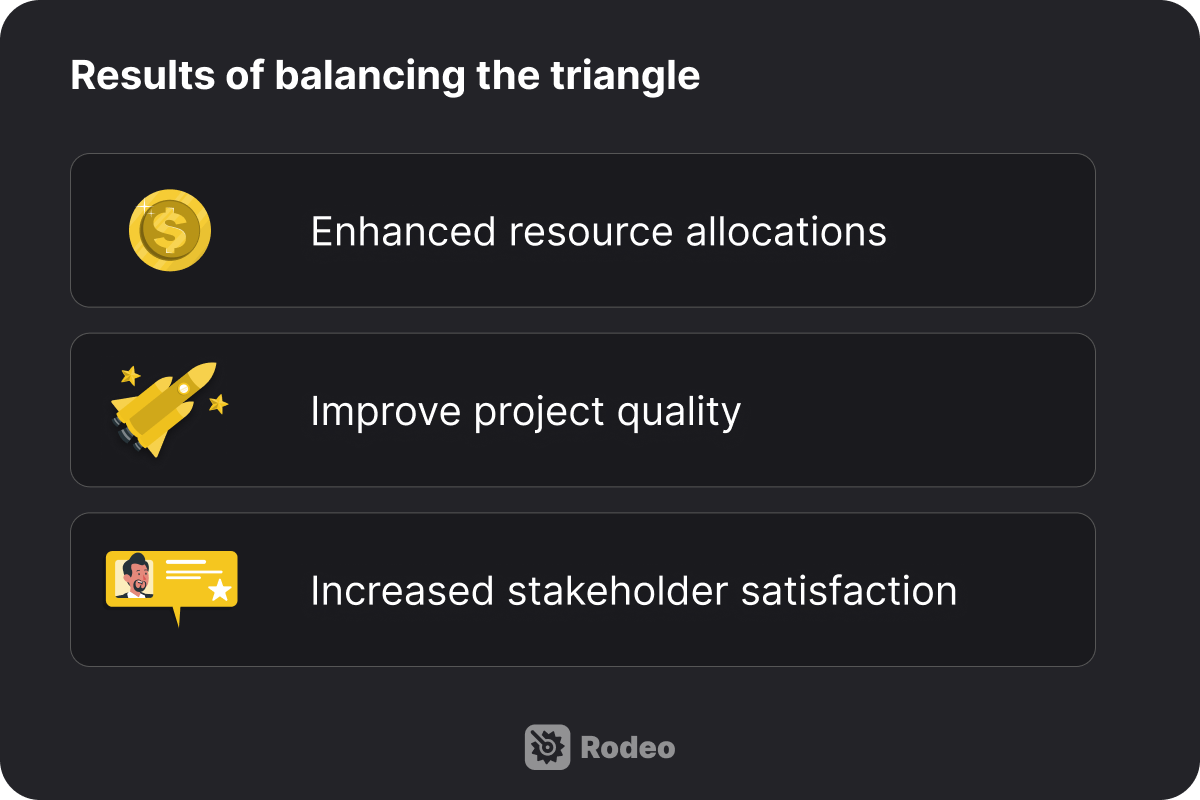
So we’ve established the interactions between the variables in the project management triangle and touched on the idea that balancing the triangle produces better outcomes. Let’s cover the benefits of a balanced triangle.
Enhanced resource allocations
When the project triangle is balanced, resource allocations tend to be sufficient for completing the project on time and within budget.
If the scope of a project is impossibly large, then regardless of resource allocations, the project will still be difficult to complete on time. Or if a project timeline is mismanaged and at risk of missing a looming deadline, then allocating more resources than planned will likely be the only solution.
Having a manageable scope, a realistic timeline, and a controlled budget prevents resources from being overutilized, leading to burnout and lower quality output, or underutilized, leading to idle time.
This balance also allows project managers to be flexible with their reallocations as projects evolve.
Improve project quality
Balancing the triangle enhances the agility and resilience of projects. It’s intuitive, but if a team has enough budget, sufficient time, and can manage the scope of the work, then they’ll tend to deliver better work.
Having that balance also equips teams with the flexibility to adapt if requirements change or unforeseen obstacles pop up.
Increased stakeholder satisfaction
Finally, balancing the triangle keeps projects in line with the expectations of project owners and stakeholders.
Each of the constraints, after all, aligns with some part of stakeholder expectations. The scope represents what stakeholders want delivered from the project. The cost represents the budget those stakeholders have invested in the project. And time represents when they expect the project to be delivered. Staying in line with each of these keeps stakeholders satisfied and supportive of the project.
8 tips for balancing the project management triangle
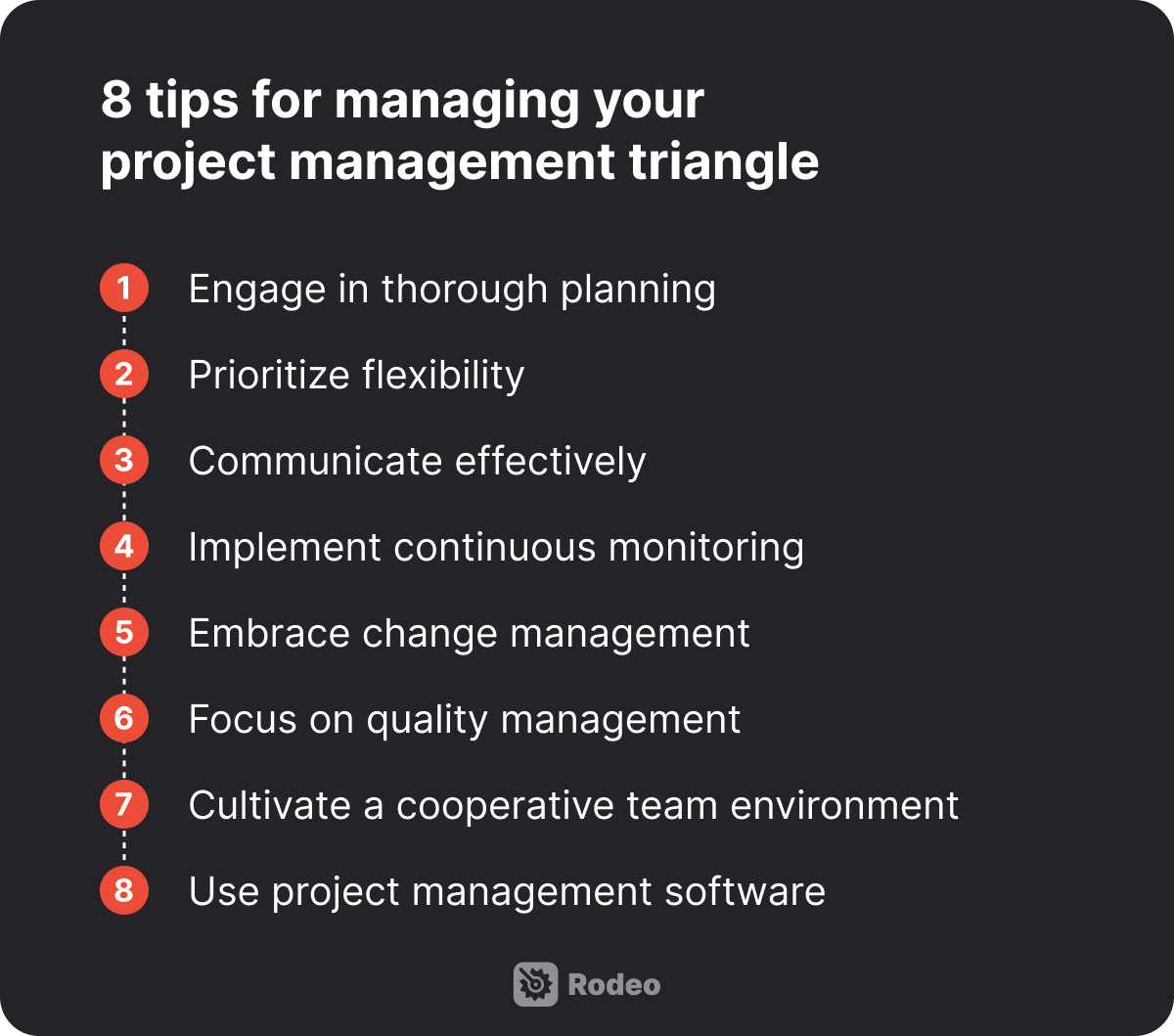
With a full picture of how the project management triangle works, let’s get into the balancing act itself. Here are eight important tips for keeping scope, cost, and time balanced in your projects.
1. Engage in thorough planning
Detailed project plans, including clear scope statements, well-defined success criteria, and comprehensive budget forecasts, are foundational documents for controlling the elements in the iron triangle. The first two help with managing time and scope, while forecasting a budget helps with managing costs.
These plans should account for potential risks and include contingency measures in some form of documentation like a risk register.
Also read: Keep Your Projects on Track With a Free Risk Register Template
2. Prioritize flexibility
While planning is crucial, project environments aren’t always predictable, so maintaining some flexibility is key. Some project management methodologies, like the agile methodology, emphasize this principle, preferring adaptability to change over strict adherence to plans. This doesn’t work in every project context, however.
Still, project managers should leave enough slack in their plans to accommodate potential changes, especially when it comes to schedules and resource availability. With changes to the project scope itself, it’s important to have change management processes like a change control board in place.
3. Communicate effectively
Establishing open and consistent channels for communication between project participants — from team members to sponsors — keeps everyone rowing in the same direction.
Project managers use a communication plan to address when regular project updates, meetings, and feedback sessions will take place throughout a project timeline. Structuring communication helps with identifying potential scope, cost, and time issues early — allowing them to be resolved before they impact the larger project.
Using project management tools and apps like Slack can facilitate collaborative problem-solving of project issues by providing a centralized place for project participants to access updates, share documents, and deliver feedback.
4. Implement continuous monitoring
Project managers need to have the ability to monitor project activities, budgets, and time use. Doing so allows them to make sure progress is going as planned, identify if the project is moving off its course, and promptly take corrective action.
The regular status reports and dashboards provided by project management software can facilitate ongoing monitoring.
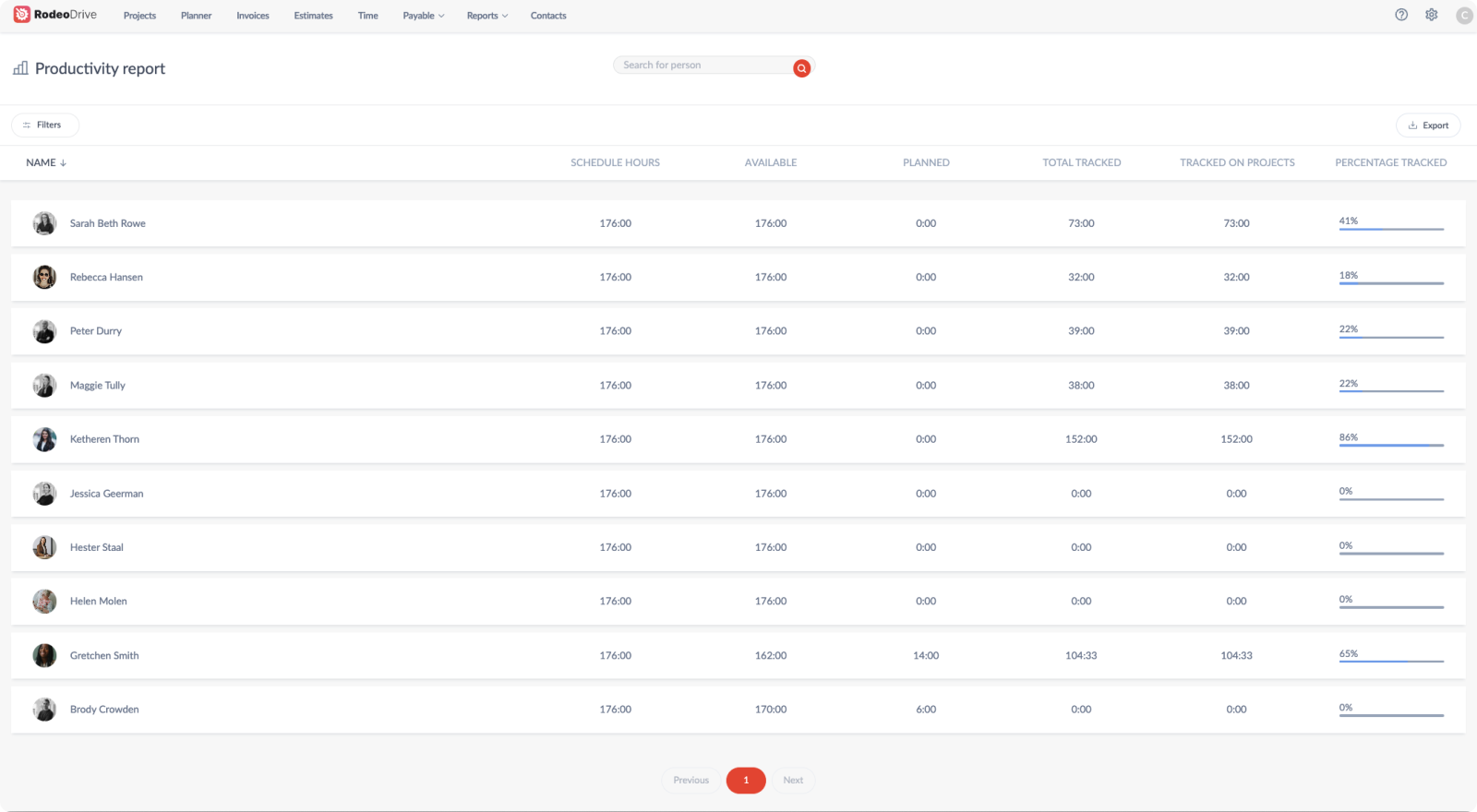
Rodeo Drive’s Productivity report provides an overview of how your team spends their time
5. Embrace change management
Since change is inherent in most projects, a structured change management process helps in assessing the impact of changes on the project’s scope, cost, and time, ensuring any adjustments are controlled and systematic.
However a team chooses to structure their change management process, it should include an evaluation of the change, an approvals process, and clear communication of the change to all stakeholders.
6. Focus on quality management
Arguably, the purpose of balancing the triangle is to make sure your teams are well-positioned to deliver quality results. Quality management refers to making sure that deliverables meet predefined standards, even as scope, cost, and time constraints are in flux.
When planning your project schedule, it’s important to factor in enough time for review cycles and quality assurance, so that adjustments in the triangle don’t compromise the quality of the project.
Quality management refers to making sure that deliverables meet predefined standards, even as scope, cost, and time constraints are carefully balanced. It’s about factoring in processes like review cycles and iterative testing into the project schedule, such that adjustments to scope, cost, or time don’t compromise the quality of the project.
7. Cultivate a cooperative team environment
Getting your team on the same page when it comes to project goals and objectives is a precondition for project success. That means providing every member of the team with a clear understanding of the project’s larger goals and intentions.
A large part of this comes from encouraging open communication, accountability, and collaboration. Building these principles into your work culture creates project teams that can more readily adapt to changes and make good decisions that uphold the project’s constraints.
8. Use project management software
The best project management software offers comprehensive tools that assist in every aspect of managing the project management triangle.
From scheduling and resource allocation tools to budget tracking features, these tools provide a unified view of the project's progress and constraints. Project managers should leverage these tools to streamline processes, enhance team collaboration, and provide real-time visibility into the project's status, helping teams make informed decisions quickly.
Balance the project management triangle with Rodeo Drive
That’s all for theory. If you’re ready to make your projects more profitable and efficient, a project management solution like Rodeo Drive can make life a lot easier for you and your team. It has a suite of tools for planning projects, managing budgets, and tracking time — handling all the elements of the project management triangle, in short.
Here are some of the features that thousands of creatives use to deliver projects.
Create accurate, real-time budgets to control project costs
Being a financially focused project management tool, Rodeo Drive is designed to help agencies and project teams work around cost constraints and enhance the profitability of their work.
At the heart of Rodeo Drive is phase-based budgeting, which helps teams categorize costs according to the stages of their work. Costs can be organized into time activities, which represent billable hours, and expense activities, which reflect the cost of supplies and equipment for the project.
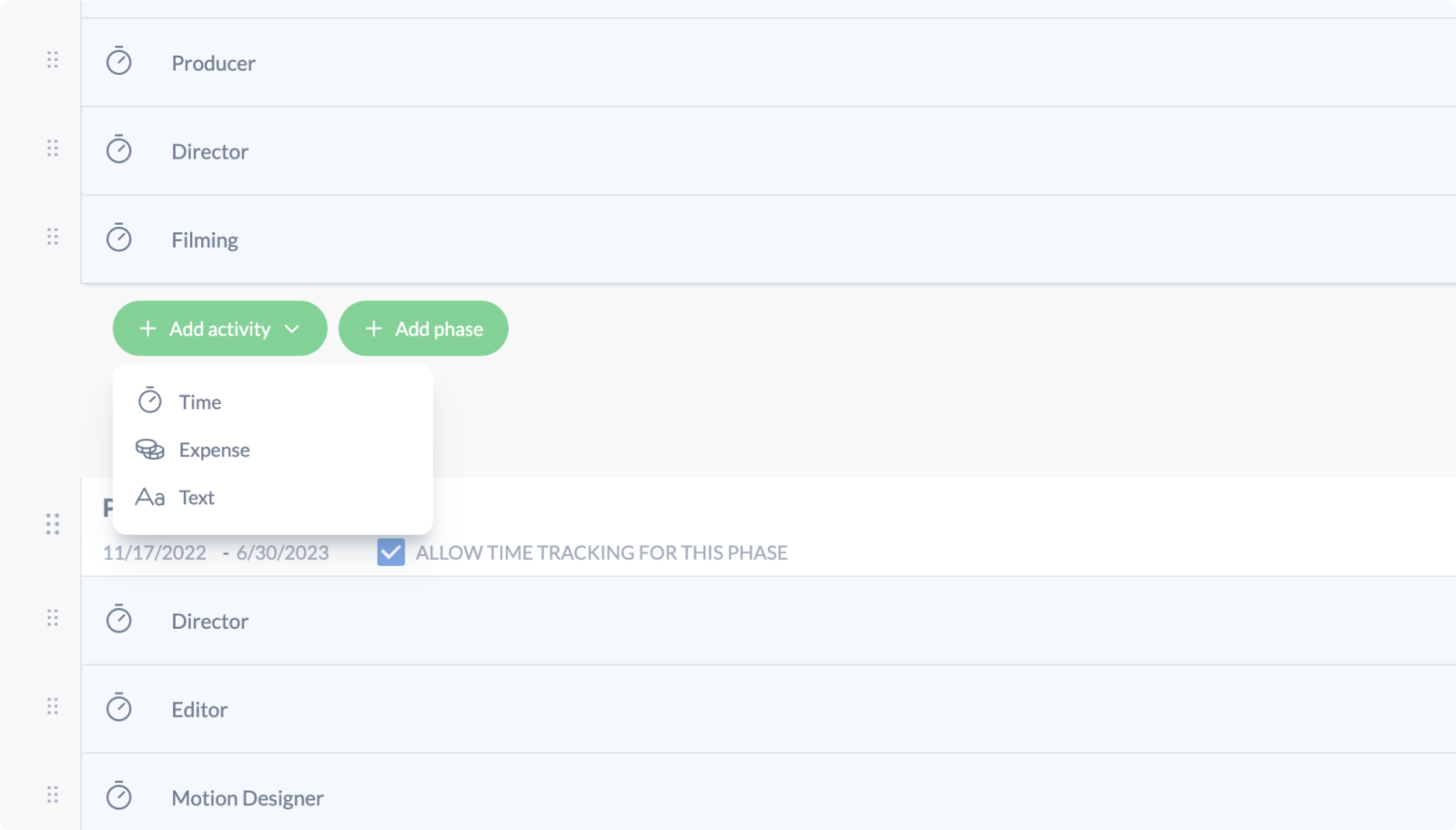
Planning project expenses is simple with Rodeo Drive
Once costs are added to the platform, Rodeo Drive will calculate the total cost of each project phase and the entirety of the project. From there, you can add markups to enhance profitability, send personalized quotes with your branding to clients, and send custom invoices through QuickBooks.
Budget metrics then update in real-time as team members log billable hours, making it easy to keep an eye on your team’s spending.

Real-time, at-a-glance budget metrics that update with tracked time
Schedule and track time for efficient execution
Using the calendar-view planner, project managers can schedule project activities and assign them to team members on a visual timeline. The planner allows team members to align their work across multiple ongoing projects — minimizing potential schedule conflicts.

Allocate team members to activities in the visual timeline planner
Project managers can use the visual planner to ensure timelines for deliverables are realistic and achievable. The left-hand side of the planner indicates how many hours are budgeted for each project activity, while the people-view of the planner offers an instant representation of team member availability.
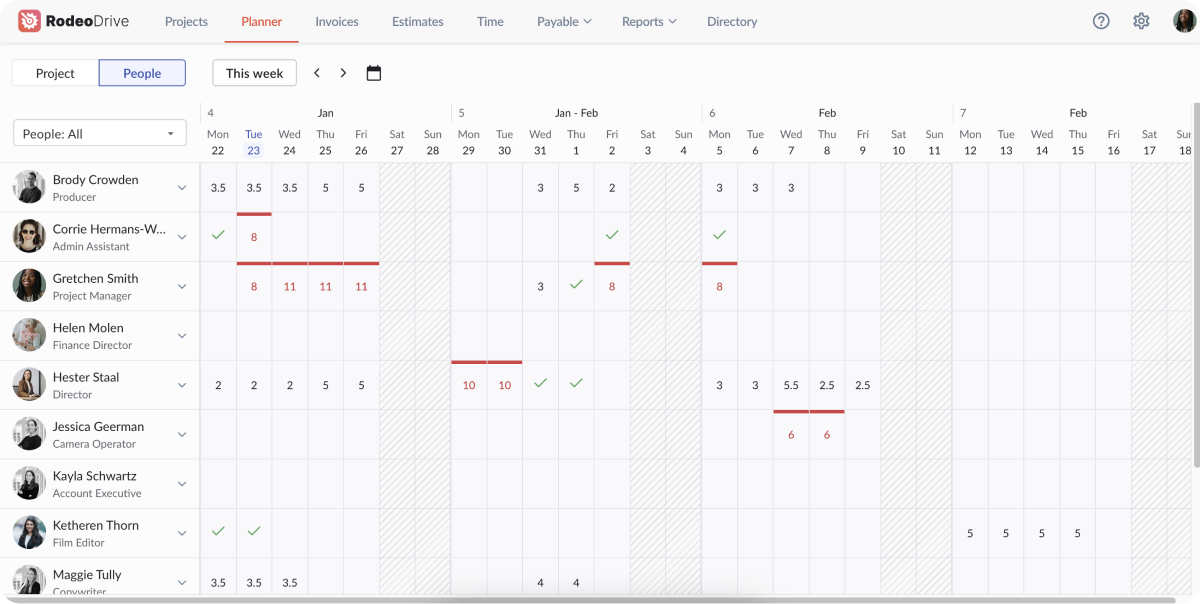
Identify your team’s available capacity with the people-view planner feature
Time tracking in Rodeo Drive helps with managing both time and budget constraints.
For time constraints, it enables project managers to see how time actuals compare to planned time allocations.
This means, for example, if a planned project activity has 30 project hours allocated to it throughout its three-month lifecycle, but ends up consuming 25 hours within the first month, the project manager can identify the overspending and adjust to either make the activity more efficient or deprioritize it to prevent delays in more critical tasks. Plus, for future projects, the team can budget time more accurately to reflect the real duration of that activity.
And time-tracking in the platform is connected to project budgets. This means that as budgets update in real-time to reflect billable hours and the cost of those activities. This enables teams to get ahead of budget overruns and update pricing to reflect the true cost of work for the organization.

Free team members from timesheets with set it and forget it time-tracking
Reporting to keep an eye on scope
Project reports in Rodeo Drive keep project managers updated on project progression. The time reports are especially useful for controlling project scope.
Time reports in Rodeo Drive display how much time individual project activities are consuming, and the cost of the time spent on those activities. For project managers, this makes it simple to assess if certain activities are overprioritized, or consuming either too much time or budget.
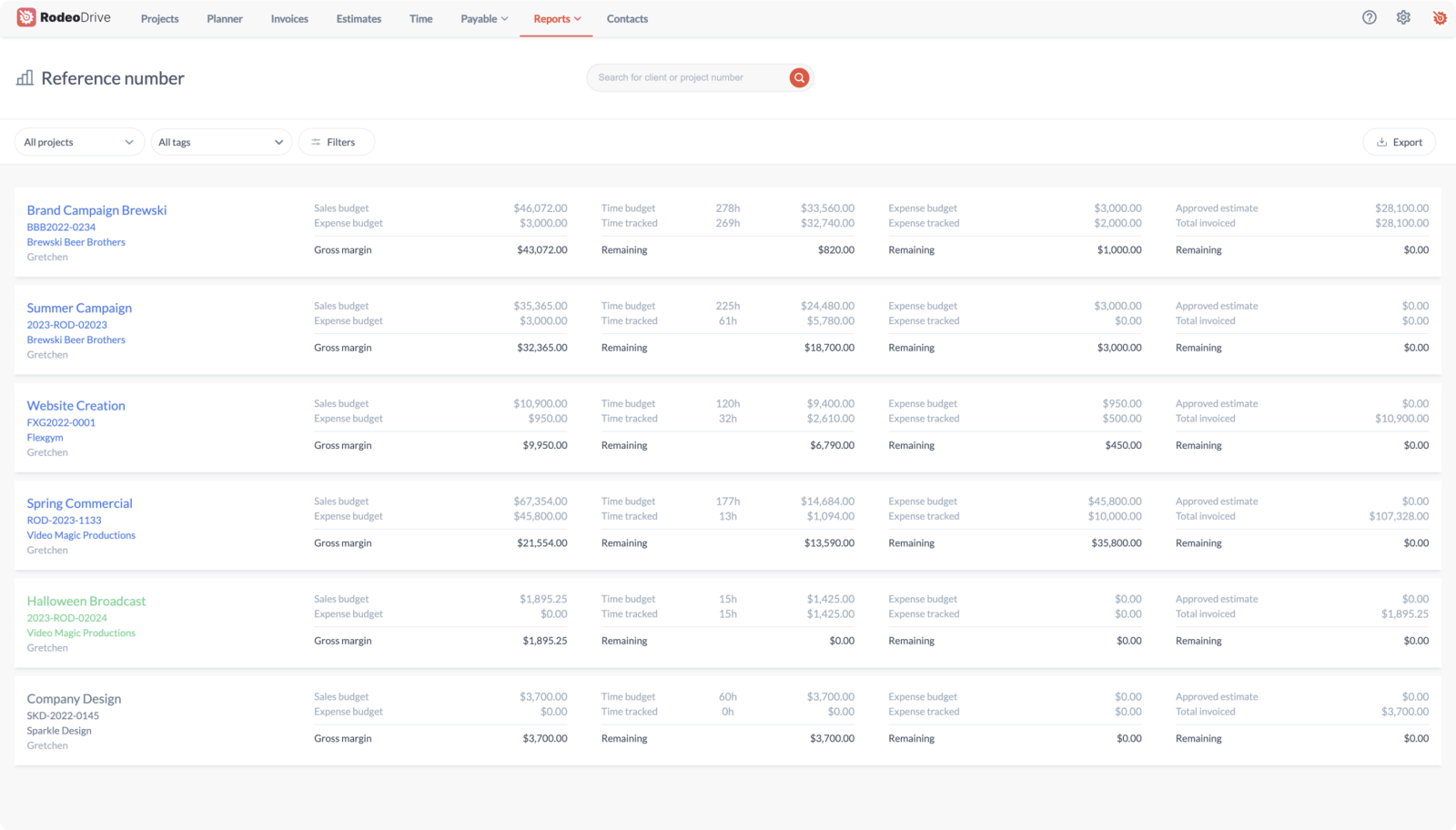
Oversee your team’s financial performance with the Projects report
Using this information, it’s then possible to cut down time allocations for non-pressing activities and reposition team members to tackle more essential priorities.
Still — it’s one thing to just take our word for it. You can use Rodeo Drive for free today. Some teams have even achieved 30% greater project profitability using it.





